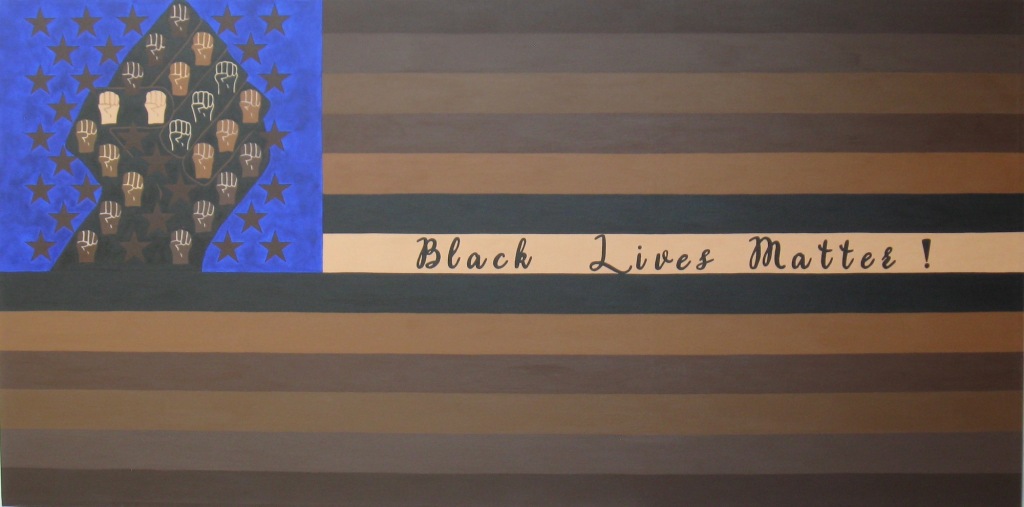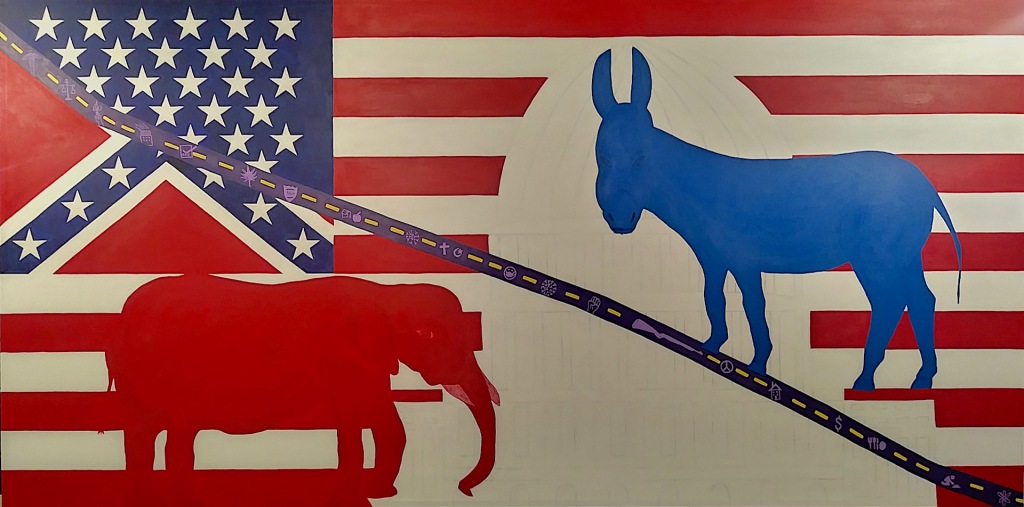I have created through my “Reimagined American Flags Series” visual representations of my perspective on major issues in the US today: 1) problems with xenophobia, bigotry, and anti-immigration policies; 2) the disproportionate killing of innocent African American men, women, and children; 3) the unprecedented deaths due largely to unregulated access to not just handguns but also military-grade AK 47 assault rifles; 4) challenges to our religious freedoms; 5) the underlying racism in the Third Verse of our national anthem, 6) how I interpret the concept of intersectionality, 7) words from the homeless on homelessness, 8) the tension between the ideal of an immigrant nation and the current reality of white nationalism, 9) a nation in constitutional crisis, 10) how after George Floyd’s murder people within all 50 states united behind the Black Lives Matter movement in support of Black power, and 11) possible pathways for bipartisan cooperation for a divided nation. These flags are intended to stimulate constructive conversations on various ways to understand what it means “to be American” or a “true patriot”. They are also intended to stimulate thoughts about why and how we need to be more humane with one another, respectful of our differences, more civil in our interactions, and willing to engage in difficult conversations to help bridge all that divides us conceptually as a nation. The reimagined American flags series not only express how I see where the US fails in its ideals and what I believe is possible but also I hope may inspire solutions to how we can make the US a safer place for all its citizens to live out their lives fully. The size of most of the original oil paintings in this series are 4′.5″ x 9′. (Exceptions are #5 & 7)
1. All Lives Matter 2015

In keeping the overall structure of the American flag, I convey the diversity within the US by incorporating the world’s flags and the phrase “All Lives Matter.” With this integration, I both symbolize our nation’s internal diversity and criticize its hypocritical xenophobia. This flag also illustrates that words matter by integrating the controversial phrase “all lives matter” as well into the strips. The change from “Black” to “All” in the phrase “All Lives Matter” was used negatively to shift attention away from the just concerns of the “Black Lives Matter” movement. This change in wording raised for me as well the “red flags” of xenophobia, anti-immigration policies, and discrimination against others based on nationality, ethnicity, and race that many of the same people who embraced “ALM” against “BLM” may well have also hypocritically supported. I decided not to dismiss but rather to engage with those who argued “All Lives Matter” in opposition to “Black Lives Matter” by pushing their phrase to what I saw as its logical end. I both attempted to call their bluff and challenge them to think about what they actually mean by this phrase. Do they really mean to include the full diversity of Americans who make up the US as fully American as they are as I’ve represented here by embedding flags from all recognized nation-states within the stripes of the US flag? This flag also visually represents the “tossed salad” rather than “melting pot” metaphor as more appropriate for accepting the distinct cultural, ethnic, and racial identities in the US. I created an American flag that I think better represents the US as an immigrant and multi-racial nation that simultaneously also challenges those who embraced the ALM over BLM phrase to more deeply examine what they mean by using this phrase.
This flag has been discussed twice on public radio:
- Claudia Shambaugh, host of “Ask a Leader: Inquiring minds wanna hear,” at KUCI (K-University of California Irvine) radio station covered the Orange County Center for Contemporary Art’s “Art as Protest” exhibition (June 2017) in a public radio exchange titled Art as Protest in Santa Ana with the guest curator of the exhibition, Tyler Stallings. They focused specifically on the artist’s intention behind and people’s reaction to Kelly’s artwork “Reimagined American Flag Series: ALM flag.” The interview with Stallings starts at 30:49 and they discuss this painting from 35:20-39:05.
- Mindy Todd, host of “The Point” at local NPR’s WCAI station of Cape Cod, interviewed Benton Jones, Executive Director of Cape Cod Museum of Art about the “We the People” exhibition (March 28, 2019). He briefly mentioned Kelly’s Collage Key for her ALM Flag as one of the art works representative of the show (7:22-7:44)
2. Black Lives Matter! 2015-16

After the Baltimore uprisings, I painted a “Black Lives Matter” flag. The black and white stripes symbolize our nation’s major racial divide. The “50 states of black” stars represent diversity within the African-American community. Names of African-American women and men are integrated into the stripes. Red names indicate those who were killed or assassinated before they could fully live their lives. Black and white names commemorate those who have made their mark in many ways. The red Y in the center asks “Why” is this still happening? Declares “Why Black Lives Matter!” And symbolizes the gesture “Hands up don’t shoot!” Just below the “V” is the only Caucasian who merited being put on the flag. Abraham Lincoln was the first president who, over 150 years ago, decided that black lives mattered by freeing the slaves and was assassinated as a result. The flag’s design both asserts that black lives matter and names those whose lives have deeply mattered in US culture along with those whose lives have been tragically cut short. This juxtaposition provokes the question: What could have Tamir Rice, and others like him, contributed had they been given the chance to live their lives? I believe that the racism at the foundation of the Civil War of the 1860s was never resolved. And the goals of the Civil Rights Movement of the 1960s were never completed. So here we are today still dealing with some failures of both. Now with so many supporting the Black Lives Matter movement we have a chance for meaningful change for a better future for African Americans, which I believe is fundamentally better for the future of all people in the US. I have reimagined an American flag that not only I can believe in but also I hope can inspire a meaningful dialogue and vision about how we can make the US a safer place for all its citizens – especially my fellow Black Americans – to live out their lives fully.
3. Don’t Lives Matter? 2016

This US flag symbolizes lives lost due to gun violence. Alternating the stripes in orange and yellow symbolizes the colors we use to indicate safety (so that people don’t shoot you in the woods) and caution (once someone has already been shot). The stars in “50 shades of red” represent the pain, suffering and grief as well as anger, rage, and despair people experience having lost loved ones. Integrated into the stripes, the dates, place names, and numbers of deaths from mass shootings from 1966-2016 to illustrate how greater access to military-grade weapons has led to more massacres. The Xs quote the X-code FEMA used on houses during the Katrina disaster to indicate from left going clockwise the following information: 1) the rescue unit #, 2) date investigated, 3) what was found, and 4) # of survivors and dead. The numbers in the Xs on this flag indicate from left going clockwise the following information: 1) the number of survivors (in black), 2) the total number of casualties (in black, not including the perpetrators), 3) the number of innocent people killed (in red), and 4) the number of perpetrators (in black if survived, in red if killed or committed suicide). One bullet begins the sequence in the upper left corner and three bullets form an ellipsis at the end indicating the inevitability of more mass shootings in our future without any substantive efforts to control guns or improve gun safety in the US.
4. Founded on the Freedom of ? 2017

This flag focuses on religious freedom and diversity in the US and challenges the hypocrisy of those who say the US is a Christian nation. The 50 stars form the peace sign and the stripes are in alternating shades of blue representing the concept of heaven and the realm of spirituality central to many religions. Symbols representing a wide range of religions form a large question mark at the center of the flag invoking one of the fundamental principles our country is founded on, namely the freedom of religion.
5. What Didn’t Make the Cut in the Third Verse 2017

I wrote out Francis Scott Key’s controversial third verse into the US flag’s thirteen stripes spelling out in parentheses the racist ideas that I think lay behind his words but didn’t “make the cut” in Key’s final version. I based these insertions on the historical scholarship about the slaves who joined to fight for the British as the Black Corps of the British Colonial Marines in exchange for their freedom during the War of 1812.
6. I’m a lot of things and you? 2018

Understanding the binaries society imposes on us and how the concept of intersectionality allows them to become more visible, opens up other possibilities to understand ourselves and how we perceive others. This painting shows not only the way multiple identities intersect within ourselves but also how these affect our perspectives on others as well. The first layer depicts major societal binaries, the second layer depicts humans as stars in various “racial” mixes, the top layer is my self-portrait. The photo of myself behind the canvas conveys that a photo of anyone can replace mine but the words chosen for their intersectional self-portrait would differ.
7. Daily Issue: Homelessness 2018

I decided to create this piece on “homelessness” from the perspective of the homeless themselves by using the tools – magic marker, pen, and pencil – and materials – torn cardboard boxes – that are readily available to homeless people to convey their reasons for being on the streets, their immediate needs, humor, and despair. Creating the shape of a house symbolizes how resourceful the homeless are with using cardboard boxes, and many other thrown-away materials, to build temporary shelters for themselves and thereby express their basic humanity.
8. Look at U.S. – “Christian” or Immigrant Nation? 2019
“…the people say the closing of your doors will never shut us out, the closing of your doors can only shut you in.”
Quoted from “Look at Us,” American Humanity, Native-American author, poet, actor, musician, and political activist John Trudell (1946-2015).
This US flag shows the hypocrisy of a so-called “Christian” nation practicing the egregious abduction of children from families legally seeking asylum in the US. The wall, the criminalization of asylum seekers, the Muslim ban, and tariffs threatening this country’s foundation as an immigrant nation all have been making me lose sleep. The US is represented by red to honor that it was once Native American land. Mexico is in yellow to represent its Latino population. Along with black, brown, and white stripes, these five colors symbolize the colors of humanity. The Klansman on the cross represents the imperialist-racist side of Christianity that continues in Trump’s WH. While the families are separated at the borders – represented by a couple on the Mexican side – their children (represented symbolically on the US side) are abducted and dispersed across the country in detention centers as if chattel from days of slavery, many without clear paths back to their own parents. The barbed-wire wall starts at the Mexican border and lassos the entire country, the end result of the WH logic of stopping the “browning” of America. The balanced red, brown, black, yellow, and white stars, in contrast, express the ideal of an immigrant nation.
9. We The People: S.O.S. 2019

10. 50 States United for Black Lives Matter! 2020

11. Divided or United States? 2021

